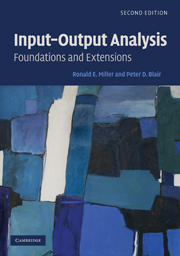Book contents
- Frontmatter
- Contents
- List of Figures
- List of Tables
- Preface
- 1 Introduction and Overview
- 2 Foundations of Input–Output Analysis
- 3 Input–Output Models at the Regional Level
- 4 Organization of Basic Data for Input–Output Models
- 5 The Commodity-by-Industry Approach in Input–Output Models
- 6 Multipliers in the Input–Output Model
- 7 Nonsurvey and Partial-Survey Methods: Fundamentals
- 8 Nonsurvey and Partial-Survey Methods: Extensions
- 9 Energy Input–Output Analysis
- 10 Environmental Input–Output Analysis
- 11 Social Accounting Matrices
- 12 Supply-Side Models, Linkages, and Important Coefficients
- 13 Structural Decomposition, Mixed and Dynamic Models
- 14 Additional Topics
- Appendix A Matrix Algebra for Input–Output Models
- Appendix B Reference Input–Output Tables for the United States (1919–2006)
- Appendix C Historical Notes on the Development of Leontief's Input–Output Analysis
- Author Index
- Subject Index
1 - Introduction and Overview
Published online by Cambridge University Press: 05 June 2012
- Frontmatter
- Contents
- List of Figures
- List of Tables
- Preface
- 1 Introduction and Overview
- 2 Foundations of Input–Output Analysis
- 3 Input–Output Models at the Regional Level
- 4 Organization of Basic Data for Input–Output Models
- 5 The Commodity-by-Industry Approach in Input–Output Models
- 6 Multipliers in the Input–Output Model
- 7 Nonsurvey and Partial-Survey Methods: Fundamentals
- 8 Nonsurvey and Partial-Survey Methods: Extensions
- 9 Energy Input–Output Analysis
- 10 Environmental Input–Output Analysis
- 11 Social Accounting Matrices
- 12 Supply-Side Models, Linkages, and Important Coefficients
- 13 Structural Decomposition, Mixed and Dynamic Models
- 14 Additional Topics
- Appendix A Matrix Algebra for Input–Output Models
- Appendix B Reference Input–Output Tables for the United States (1919–2006)
- Appendix C Historical Notes on the Development of Leontief's Input–Output Analysis
- Author Index
- Subject Index
Summary
Introduction
Input–output analysis is the name given to an analytical framework developed by Professor Wassily Leontief in the late 1930s, in recognition of which he received the Nobel Prize in Economic Science in 1973 (Leontief, 1936, 1941). One often speaks of a Leontief model when referring to input–output. The term interindustry analysis is also used, since the fundamental purpose of the input–output framework is to analyze the interdependence of industries in an economy. Today the basic concepts set forth by Leontief are key components of many types of economic analysis and, indeed, input– output analysis is one of the most widely applied methods in economics (Baumol, 2000). This book develops the framework set forth by Leontief and explores the many extensions that have been developed over the last nearly three quarters of a century.
In its most basic form, an input–output model consists of a system of linear equations, each one of which describes the distribution of an industry's product throughout the economy. Most of the extensions to the basic input–output framework are introduced to incorporate additional detail of economic activity, such as over time or space, to accommodate limitations of available data or to connect input–output models to other kinds of economic analysis tools. This book is an updated and considerably expanded edition of our 1985 textbook (Miller and Blair, 1985).
In this chapter we introduce the basic input–output analysis framework and outline the topics to be covered in the balance of the text. Appendix C provides a historical account of the work leading up to Leontief's formulation and its subsequent development and refinement.
Information
- Type
- Chapter
- Information
- Input-Output AnalysisFoundations and Extensions, pp. 1 - 9Publisher: Cambridge University PressPrint publication year: 2009
